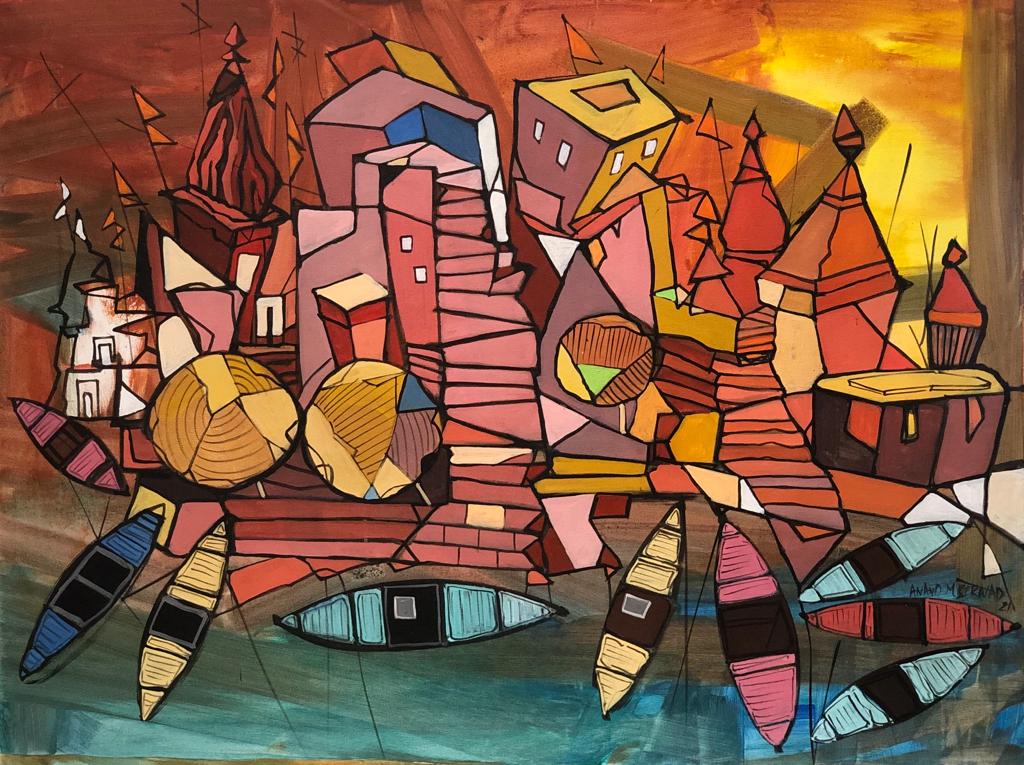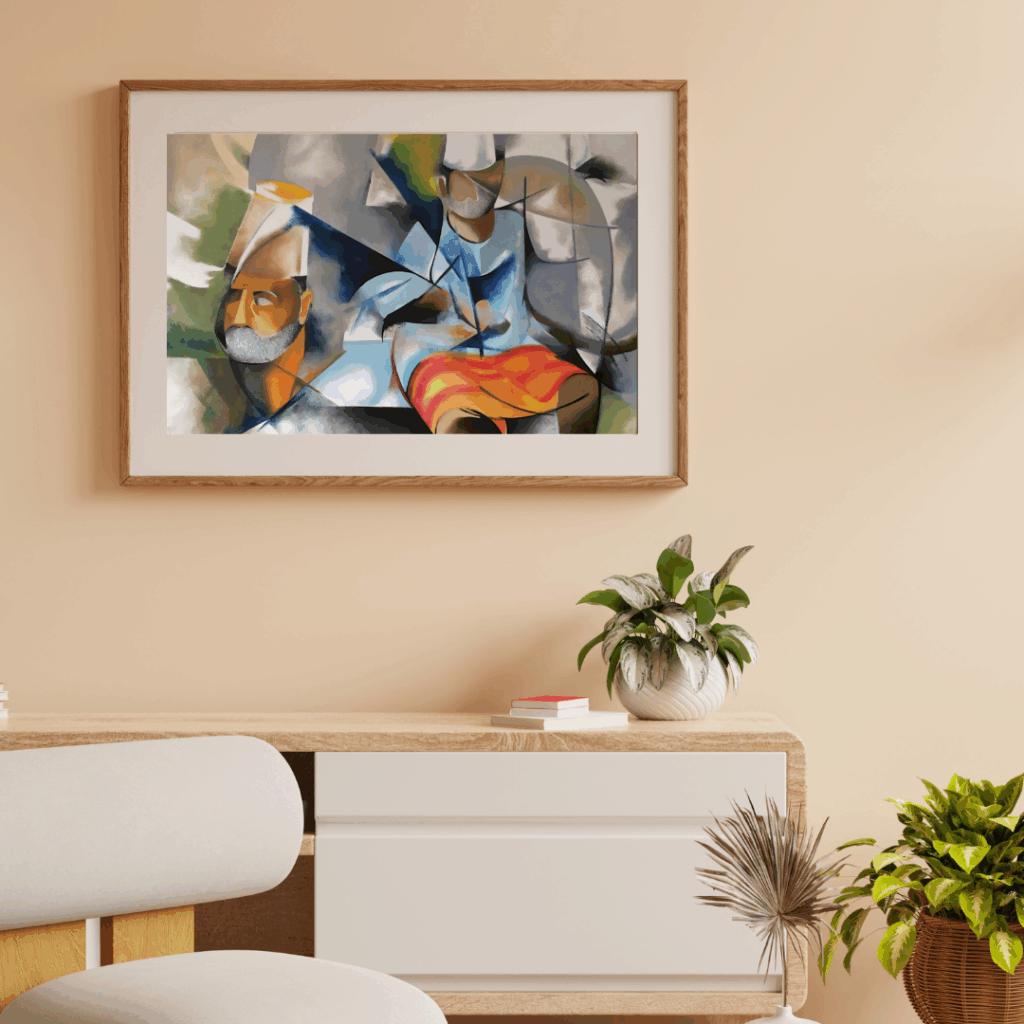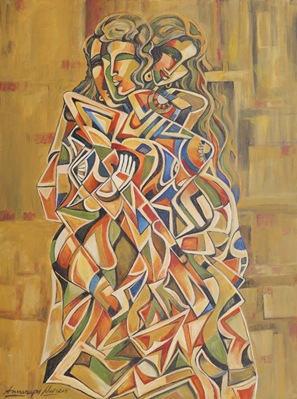There’s something truly fascinating about the way Indian artists have always adapted and reimagined global art movements. One such case—perhaps one of the most compelling—is the way Cubism, a Western modernist style born in early 20th-century Europe, found new life in Indian hands.
But here’s the thing: Indian artists didn’t just imitate Cubism—they transformed it. They gave it rhythm, mythology, memory, and spirit. At Mojarto, we’ve seen this unique transformation unfold through a growing interest in artworks that blend geometric abstraction with stories deeply rooted in Indian culture. This is Cubism through a distinctly Indian lens—complex yet familiar, modern yet unmistakably traditional.
If you’re someone who’s been looking to explore contemporary Indian art that pushes boundaries but still carries cultural weight, Indian Cubism might just speak your language.

A Global Movement Meets Indian Sensibilities
Originally pioneered by Pablo Picasso and Georges Braque, Cubism shook the art world by rejecting realism and instead breaking forms into fragmented shapes. It encouraged viewers to see the world from multiple perspectives at once. That’s powerful, but when Indian artists embraced Cubism, something interesting happened.
Instead of stripping away narrative like their European counterparts often did, Indian artists infused the structure of Cubism with storytelling. You’ll often find familiar figures—gods, musicians, villagers, animals—told through abstract geometry, where planes and angles echo India’s own ancient visual language, from temple carvings to folk murals.
This blend has given rise to a genre that’s emotionally rich, visually bold, and intellectually rewarding.
Why Collectors Are Paying Attention
There’s a reason why Indian Cubist art has been catching the eyes of collectors and curators over the past few years. We’ve seen the trend firsthand at Mojarto—whether it’s young professionals buying their first piece or seasoned collectors adding to their portfolio, there’s an increasing appetite for works that balance contemporary style with cultural substance.
So what’s driving this demand?
- It feels modern without being cold: Cubism, especially the Indian adaptation, fits beautifully into today’s interiors, minimalist or eclectic.
- It’s layered with meaning: Many works tell stories or evoke ideas that reflect Indian life, spirituality, or philosophy, making them more than just art—they’re experiences.
- It’s a smart investment: With Indian contemporary artists gaining global recognition, these artworks have strong potential for value appreciation.
And perhaps most importantly, these artworks feel personal. They invite interpretation, spark conversation, and reflect a taste that goes beyond trends.
Artists Who’ve Redefined Cubism in India
If you look closely at the evolution of Indian modern art post-independence, you’ll notice that Cubist influence runs like an undercurrent through many well-known artists’ works—even if they weren’t strictly “Cubists” in the traditional sense.
- M.F. Husain, for example, often used fragmented forms in his early paintings, blending mythology and motion into a language of his own.
- F.N. Souza’s raw, distorted portraits were as emotionally intense as they were structurally experimental, drawing on Cubist ideas but with a rebellious twist.
- Ram Kumar’s haunting, abstracted cityscapes, stripped of human presence, echoed a philosophical emptiness wrapped in Cubist geometry.
- Jehangir Sabavala, on the other hand, brought a meditative calm to his works, layering space with structured form and soft hues.
Today, a new generation of Indian artists is taking Cubism even further—adding digital elements, street art influences, and cultural commentary that reflects modern India. Mojarto proudly showcases many of these creators, each with their own take on what Cubism means in today’s context.
What Makes Indian Cubism So Visually Striking
What truly sets Indian Cubist art apart is its ability to hold multiple realities at once. A painting might, on the surface, appear to be a fragmented face—but look again, and you’ll find symbols of fertility, music, or folklore woven into the structure.
There’s a deliberate contrast happening here: precise geometry meets spiritual storytelling. This duality makes the artwork feel both familiar and new. You can appreciate the balance of colour and composition on a visual level, but there’s also an emotional pull that brings you back to your roots.
For art lovers who want something that goes beyond pure abstraction, this balance of form and feeling is priceless.
Cubism in Contemporary Spaces: A Perfect Fit
You might be wondering—how does Cubist art fit into a modern living or working space?
Surprisingly well.
In fact, interior designers are increasingly recommending Indian Cubist pieces to clients who want to make a statement. Whether it’s a bold canvas above a neutral sofa or a serene, structured landscape in a modern study, these artworks act as visual anchors. They break the monotony and bring focus.
At Mojarto, we often work with designers to help them curate art that not only complements the space but also tells a story. Cubist pieces, especially those with Indian themes, offer the perfect blend of sophistication and warmth.

Why Mojarto is the Best Place to Find Indian Cubist Art
There’s no shortage of online art platforms, but Mojarto offers something different. We don’t just display art—we curate experiences.
Here’s what makes us your trusted source for Indian Cubist art:
- Expert Curation: Every piece on Mojarto is carefully selected for authenticity, quality, and originality.
- Diverse Range: Whether you’re drawn to traditional narratives or bold urban experiments, we offer something for every taste.
- Verified Artists: We collaborate directly with artists across India, ensuring fair trade, genuine works, and deep artistic intent.
- Easy Discovery: Our user-friendly platform makes it simple to filter by style, size, price, and more, helping you find the perfect fit.
- Professional Support: Need guidance? Our art advisors are just a message away to help you build or grow your collection with confidence.
From first-time buyers to seasoned collectors, Mojarto is where passion meets professionalism.
A Genre That Reflects India’s Evolving Identity
Cubism in Indian art is not just a genre—it’s a mirror to how India sees itself today. It captures contradiction, complexity, and culture. It honours the past while leaning fearlessly into the future.
If you’re someone who appreciates art that is both visually powerful and intellectually stimulating, Cubist Indian works might just resonate with your sensibility.
They don’t shout. They don’t overwhelm. But they stay with you.
And at Mojarto, we believe that’s what great art should do.

Ready to Explore?
Browse our handpicked collection of Cubist Indian art today—and discover pieces that reflect your story, your culture, and your modern sensibility.